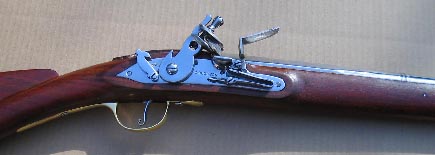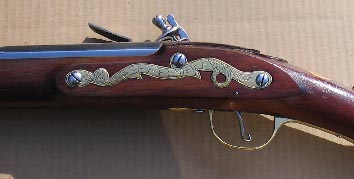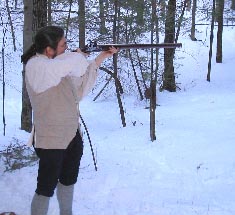| |
|
|
|
|
This is a copy of the the famous "Cookson" fowler circa 1750. The original gun was made by a Boston gunsmith using recycled parts from an early 18th century piece. The style at the time was to copy French fowlers, so the end result was a long barreled gun with a graceful drop to the stock. There is a long story about how French style stocks became popular in New England, if you ever visit the shop I will tell the whole story.
|

|
| |
|
|
|
|
Here's a view from the left. The barrel is .69 caliber and is 51" long. This is the longest production musket ever! As long as it is, the stock is slender and graceful so it weighs in at only 8.8 lbs, which is less than an Italian Charleville. Overall length is 68". |

|
| |
|
|
|
|
Here is the early 3-screw Queen Anne style doglock. It has a flat topped frizzen with no external bridle. The lockplate is marked "I. Cookson". Note the early style triggerguard. |

|
| |
|
|
|
|
The flat serpent sideplate is an early feature. Sometimes originals had a dragon's head, sometimes not. I have even seen an Indian's head on one of them. See Hamilton's book "Colonial Frontier Guns" for photos of original sideplates. |

|
| |
|
|
|
|
Here is the view from the top. The barrel is three-stage octagon to round. The barrel tang screw comes up from the bottom, another early feature. To see the original gun, turn to pg. 163 of Neumann's Battle Weapons of the American Revolution |

|
| |
|
|
|
|
Here's Charlie firing the first shot out of one of these. As long as these guns are, they shoulder well and feel natural. (and yes, he hit what he was aiming at, good show Charlie!!!) |

|
Accessories such as hammerstall, flashguard and extra long cleaning rod available separately.
|





















